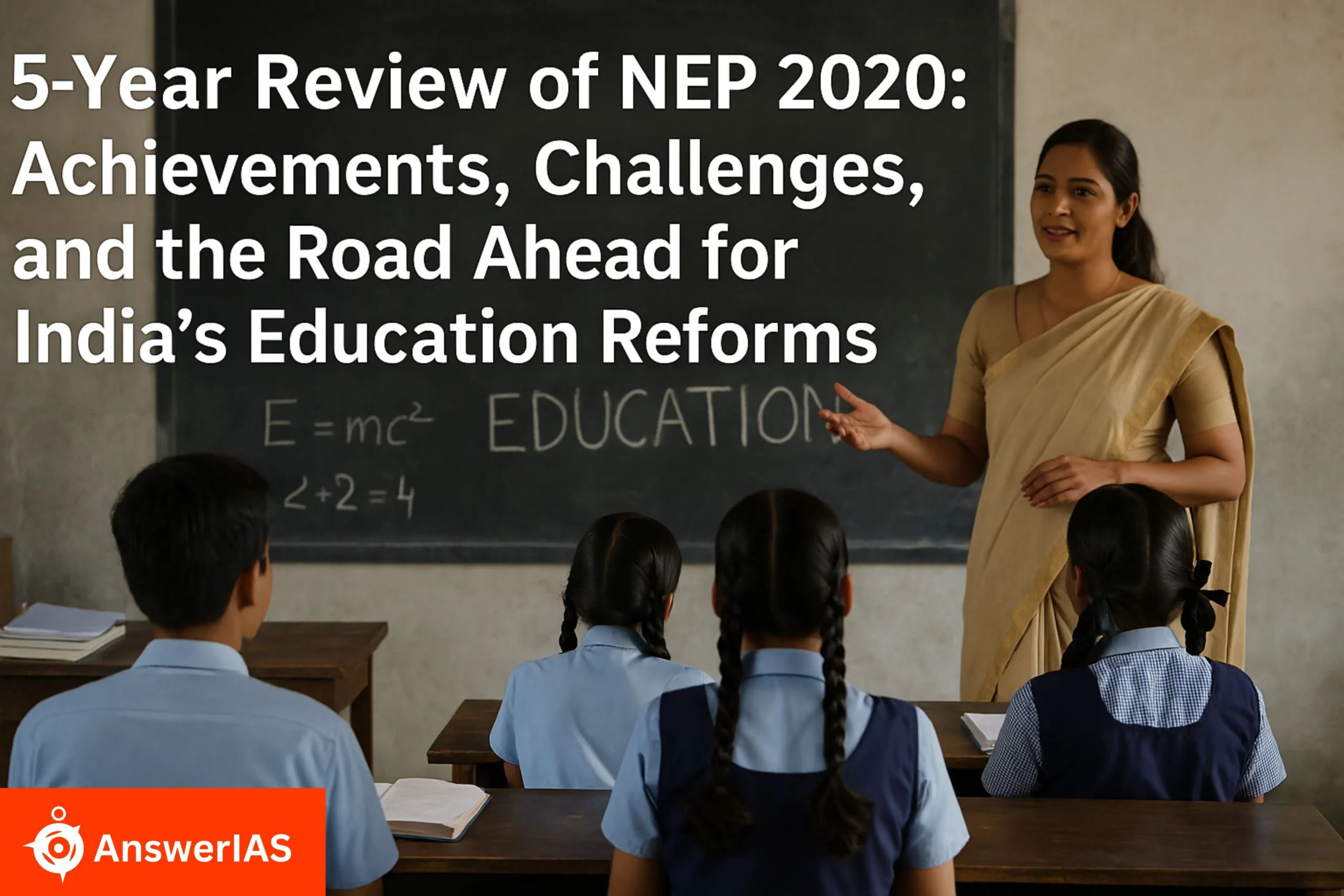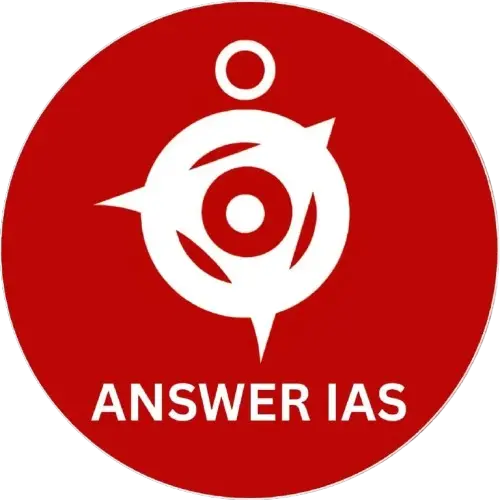
Introduction
The National Education Policy (NEP 2020) represents India’s most comprehensive educational reform in 34 years, replacing the National Policy on Education of 1986. Launched on July 29, 2020, this transformative policy aims to reshape India’s educational landscape from foundational learning to higher education, positioning the nation as a “global knowledge superpower” by 2035.
As we reach the five-year milestone of NEP 2020 implementation, it becomes crucial to assess the progress made, identify gaps, and understand the path forward. This analysis examines the policy’s vision, implementation status, and the complex interplay of achievements and challenges that have emerged during this transformative period.
What are the Main Features of NEP 2020?
The Revolutionary 5+3+3+4 Structure
The NEP 2020 5+3+3+4 structure represents a paradigm shift from the traditional 10+2 system. This pedagogical restructuring aligns education with children’s cognitive and developmental stages:
- Foundational Stage (5 years, ages 3-8): This includes three years of pre-school education followed by Classes 1 and 2. The integration of Early Childhood Care and Education (ECCE) into the formal system marks a significant departure from previous policies, recognizing the critical importance of early years in child development.
- Preparatory Stage (3 years, ages 8-11): Covering Classes 3 to 5, this stage introduces structured learning while maintaining an activity-based approach, gradually building foundational literacy and numeracy skills.
- Middle Stage (3 years, ages 11-14): Classes 6 to 8 focus on experiential learning and the introduction of subject teachers, preparing students for more specialized learning.
- Secondary Stage (4 years, ages 14-18): The most flexible stage, covering Classes 9 to 12, allows students to choose subjects across disciplines, breaking down rigid stream separations between arts, commerce, and science.
Multidisciplinary and Holistic Education
NEP 2020 eliminates artificial boundaries between academic disciplines, vocational training, and extracurricular activities. Students can now pursue creative combinations like mathematics with music or physics with history, fostering interdisciplinary thinking crucial for 21st-century problem-solving.
Emphasis on Mother Tongue and Multilingualism
The NEP 2020 policy strongly advocates for mother tongue or regional language as the medium of instruction at least until Grade 5, preferably until Grade 8. The three-language formula continues with greater flexibility, requiring at least two languages to be native to India while allowing states and students to choose based on their preferences.
Integration of Vocational Education
Starting from Grade 6, students receive exposure to vocational skills through “bagless days” and internships with local vocational experts. The ambitious target aims to provide vocational education to at least 50% of learners by 2025, bridging the gap between education and employability.
Aims and Objectives of NEP 2020
Foundational Goals of National education Policy
The NEP 2020 policy operates on five foundational pillars: Access, Equity, Quality, Affordability, and Accountability. These principles guide all aspects of implementation, ensuring educational transformation remains inclusive and sustainable.
Creating Global Citizens with Indian Roots
NEP 2020 uniquely emphasizes creating an education system “rooted in Indian ethos” while preparing students for global competitiveness. This involves integrating Indian Knowledge Systems (IKS) across disciplines, from ancient mathematics and astronomy to philosophy and yoga, as elective options in the curriculum.
Universal Foundational Literacy and Numeracy
The policy accords the “highest priority” to achieving universal Foundational Literacy and Numeracy (FLN) by Grade 3. The NIPUN Bharat Mission was launched to operationalize this goal, emphasizing low pupil-teacher ratios and development of engaging learning materials in local languages.
Transforming Higher Education
For higher education, NEP 2020 sets an ambitious target to increase the Gross Enrolment Ratio (GER) from 26.3% in 2018 to 50% by 2035. The policy envisions creating multidisciplinary institutions with flexible entry-exit options, supported by the Academic Bank of Credits (ABC) for credit portability and lifelong learning.
Five-Year Progress Report of NEP 2020 : Achievements and Gaps
School Education: Mixed Results
Foundational Literacy Improvements: The ASER 2024 report shows encouraging progress, with 23.4% of Class III students in government schools able to read Grade II-level text, up from 16.3% in 2022. However, the ambitious goal of 100% FLN by 2025 remains unmet, with only 48% of Class 3 students meeting age-appropriate reading levels.
ECCE Integration Success: Over 1.1 crore children are now enrolled in ‘Balvatikas’ (preschools), more than doubling from 50 lakh in 2018. The ‘Vidya Pravesh’ program has reached 4.2 crore students across 8.9 lakh schools, providing structured play-based learning preparation.
Implementation Challenges: Despite policy mandates, vocational education integration remains largely theoretical in many schools. The mother tongue instruction initiative faces resistance due to societal preference for English-medium education and shortage of qualified teachers in regional languages.
Higher Education: Quantitative Success, Qualitative Concerns
Enrollment Surge: Higher education enrollment increased by 30.5%, from 3.42 crore in 2014-15 to 4.46 crore in 2022-23. Female enrollment rose by 38.4%, with women pursuing PhDs increasing by 135.6%. Marginalized communities showed remarkable gains: SC enrollment up 50%, ST enrollment up 75%, and Muslim enrollment up 46.3%.
Structural Reform Delays: While 90% of Higher Education Institutions (HEIs) claim to offer flexible curricula, only 36% have implemented the Multiple Entry-Exit system. The Academic Bank of Credits, despite generating 32 crore IDs, shows low institutional integration with less than 12% active usage.
Critical Challenges and Roadblocks for NEP 2020
The Funding Crisis
Public expenditure on education remains stagnant at approximately 2.9% of GDP, less than half the recommended 6%. This chronic underfunding directly impacts infrastructure development, teacher recruitment, and new initiative implementation. The underutilization of allocated funds, with 15% of Samagra Shiksha budget remaining unspent, further complicates the situation.
Regulatory Reform Stalemate
The Higher Education Commission of India (HECI), envisioned as a single regulatory body to replace fragmented authorities, remains unestablished five years after NEP 2020 policy launch. The HECI Bill continues in drafting stages, perpetuating regulatory inefficiencies and hindering institutional autonomy.
Federal Tensions
Several states, including Tamil Nadu, Kerala, and West Bengal, resist NEP implementation citing centralization concerns. The linking of central funding to NEP adoption has created a contentious environment, with Tamil Nadu challenging fund withholding in the Supreme Court. This federal friction risks creating a fragmented education system across states.
Teacher Capacity Crisis
Teacher education reform remains the weakest link. The National Curriculum Framework for Teacher Education (NCFTE), due in 2021, remains unreleased. Teachers report receiving new curricula without adequate training, while the four-year Integrated Teacher Education Programme (ITEP) faces resistance from existing institutions.
The Way Forward: Strategic Recommendations for NEP 2020
Immediate Priorities
- Realistic Funding Roadmap: Create a binding, multi-year financial plan with clear milestones for reaching 6% GDP investment by 2030, linking fund release to qualitative achievements rather than just quantitative metrics.
- Fast-track HECI Implementation: Prioritize finalizing and tabling the HECI Bill while ensuring adequate state-level delegation to address federalism concerns.
- National Teacher Mission: Launch a mission-mode project for teacher capacity building with clear targets for upgrading Teacher Education Institutions and ensuring outcome-based continuous professional development.
Long-term Structural Changes
- Collaborative Federalism: Establish a statutory NEP Implementation Council co-chaired by Union and state education ministers to foster genuine consultation and shared ownership.
- Quality-focused Metrics: Shift primary assessment from enrollment numbers to learning outcomes, using data from PARAKH and independent surveys to track genuine educational transformation.
- Bottom-up Innovation: Create frameworks to identify, fund, and scale successful educational innovations emerging from states, districts, and institutions, allowing contextually relevant implementation.
Conclusion
The National Education Policy 2020 remains a visionary document with the potential to transform India’s educational landscape. While the first five years have shown notable successes in expanding access and improving foundational learning, significant gaps persist in funding, implementation quality, and federal collaboration.
The next phase requires moving beyond rhetoric to accountable execution. Success demands adequate funding, genuine federal partnership, focus on teacher empowerment, and unwavering commitment to quality education for every child. As India approaches 2030, the ability to bridge the gap between NEP 2020’s ambitious vision and ground reality will determine not just educational outcomes but the nation’s trajectory as a knowledge economy.
The policy’s ultimate success will be measured not by compliance statistics or enrollment numbers, but by whether it genuinely transforms learning experiences and outcomes for India’s diverse student population. This transformation requires sustained political will, adequate resources, and collaborative effort from all stakeholders to realize the dream of making India a global knowledge superpower while remaining rooted in its rich cultural heritage.
Read Other Current Affairs Article

Leave a Reply